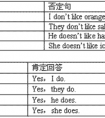Changetheformsofthefollowingsentences. 句型转换。1. I liketripsinthecar.(改为否定句) 2. Thetortoiseiswalkingdownaroad.(对画线部分提问) 3. Thepencilisinthed-六年级英语
题文
| Change the forms of the following sentences. 句型转换。 |
| 1. I like trips in the car.(改为否定句) 2. The tortoise is walking down a road.(对画线部分提问) 3. The pencil is in the desk.(对画线部分提问) 4. An elephant is bigger than a tiger.(改为同义句) 5. I don't know. Where's my sword?(连为复合句) |
答案
| 1. I don't like trips in the car. 2. What's the tortoise doing? 3. Where's the pencil? 4. A tiger is smaller than an elephant. 5. I don't know where my sword is. |
据专家权威分析,试题“Changetheformsofthefollowingsentences. 句型转换。1. I like..”主要考查你对 否定句,规则形容词的比较级,疑问副词,现在进行时,现在分词,特殊疑问句 等考点的理解。关于这些考点的“档案”如下:
否定句规则形容词的比较级疑问副词现在进行时,现在分词特殊疑问句
考点名称:否定句
- 否定句:
表示否定的句子。必须有否定词。
否定句的构成形式:
a. 谓语为be动词时,“be+not "一名学生。
b. 谓语为实义动词而且没有情态动词和助动词时,“do/ does/ did+not"构成否定。
例:I do not like dancing. 我不喜欢跳舞。
He does not want to go to school. 他不想去上学。
c. 谓语为“情态动词+实义动词”时,“情态动词+not”构成否定。
例:You must not smoke. 你千万不要吸烟。
I can not catch it. 我抓不住它。 - 否定句在英语语法中可以分为九类:
(1)一般否定句
I don't know this. No news is good news.
There is no person(smoking)/not a person/not any person(smoking)in the house.
(2)特指否定
He went to his office, not to see him.
I am sorry for not coming on time.
I don't think/believe/suppose/feel/imagine you are right.
(3)部分否定
All the answers are not right
All is not gold that glitters
I don't know all of them.
I can't see everybody/everything.
Both of them are not right.
(4)全体否定
None of my friends smoke.
I can see nothing/nobody.
Neither of them is right.
Nothing can be so simple as this.
(5)延续否定
You didn't see him, neither/nor did I.
You don't know, I don't know either.
He doesn't know English, let alone/to say nothing of/not to speak of(更不用说)French.
(6)半否定句
We seldom/hardly/scarcely/barely hear such fine singing.
I know little English. I saw few people.
(7)双重否定
You can't make something out of nothing.
What's done cannot be undone.
There is no sweet without sweat.
No gain without pains.
I can't help /keep/ laughing whenever I hear it.
No man is so old but(that)he can learn.
(8)排除否定
Everyone is ready except you.
He did nothing but play.
But for your help, I couldn't do it.
(9)加强否定
I won't do it at all.
I can't see it any more.
He is no longer a boy. 否定转移的形式与用法:
一、动词的否定转移
1.形式上否定主句的谓语,实际上是否定从句的谓语
当动词“think”、“believe”、“suppose”、“imagine”、“expect”、“feel”的主语是第一人称,谓语动词为没有任何副词修饰的一般现在时,它们的否定式实际上是对宾语从句的否定。
表示说话者提出一种委婉的看法或主张。如:
I think that he will help us.——I don’t think that he will help us. 我认为它不会帮助我们。
I believe that he is right.——I don’t believe that he is right. 我认为他不对。
I suppose that he likes it.——I don’t suppose that he likes it. 我想他不喜欢它。
2. 形式上否定谓语动词,实际上否定复合宾语
当动词“think”、“believe”、“suppose”、“imagine”、“expect”、“feel”、“find”的主语是第一人称,谓语动词为没有任何副词修饰的一般现在时,它们前面的否定式实际上是对复合宾语的否定。表示说话者所提出的一种委婉的看法或主张。如:
- 最新内容
- 相关内容
- 网友推荐
- 图文推荐
| [家长教育] 孩子为什么会和父母感情疏离? (2019-07-14) |
| [教师分享] 给远方姐姐的一封信 (2018-11-07) |
| [教师分享] 伸缩门 (2018-11-07) |
| [教师分享] 回家乡 (2018-11-07) |
| [教师分享] 是风味也是人间 (2018-11-07) |
| [教师分享] 一句格言的启示 (2018-11-07) |
| [教师分享] 无规矩不成方圆 (2018-11-07) |
| [教师分享] 第十届全国教育名家论坛有感(二) (2018-11-07) |
| [教师分享] 贪玩的小狗 (2018-11-07) |
| [教师分享] 未命名文章 (2018-11-07) |

![They ___________ like sweet things. [ ]A. don't B. aren't C. isn't-五年级英语](http://www.00-edu.com/d/file/ks/4/1/63/2019-08-31/small9cd523a0de82eff49e4ea07f34ddaa2f1567192691.gif)


![That's ___________jeep. It's a car.[ ]A. a not B. not C. not a D. not an-六年级英语](http://www.00-edu.com/d/file/ks/4/1/63/2019-08-31/small906a4f337e361f331d9a3de0dac7f65e1567192681.gif)

